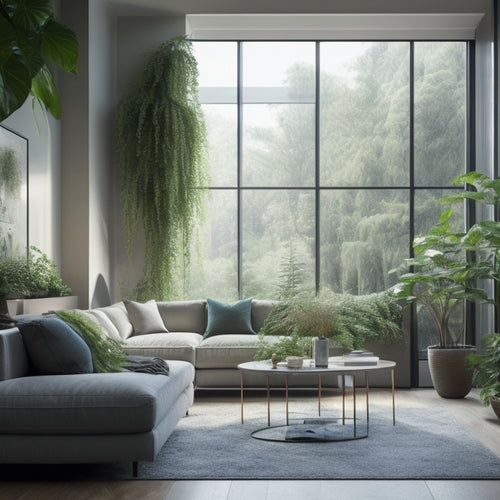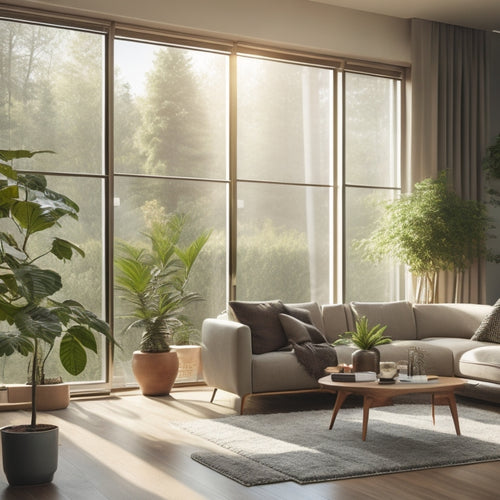
7 Green Building Innovations Using Bamboo Construction
Share
As you investigate the forefront of sustainable construction, you'll uncover bamboo's extraordinary potential to change the industry, offering a unique fusion of eco-friendliness, durability, and versatility that's revolutionizing the way we build. From Bamboo Reinforced Polymer Composites that outperform traditional materials to Engineered Bamboo for load-bearing applications, you'll find innovative solutions that support greener construction. Sustainable insulation, low-carbon concrete, and prefabricated modular housing are just a few more examples of bamboo's incredible potential. As you learn more about these state-of-the-art technologies, you'll reveal new possibilities for building a more sustainable future.
Key Takeaways
- Bamboo-reinforced polymer composites offer enhanced strength and durability for sustainable construction and infrastructure.
- Engineered bamboo products rival traditional wood in load-bearing capacity while resisting decay and insect damage.
- Bamboo-based insulation and low-carbon concrete reduce carbon footprint and support energy-efficient designs.
- Innovative bamboo panel systems provide sustainable alternatives to traditional building materials with increased design flexibility.
- Prefabricated bamboo modular housing offers cost-effective, eco-friendly, and customizable solutions for modern living spaces.
Bamboo Reinforced Polymer Composites
When engineers combine bamboo fibers with polymer matrices, they create Bamboo Reinforced Polymer Composites (BRPCs), a novel material that employs the unique properties of bamboo to produce exceptional strength, durability, and sustainability.
With the growing demand for renewable energy solutions, electric vehicle infrastructure is becoming increasingly important, and BRPCs can play a significant role in building sustainable infrastructure for the future.
You'll find that BRPCs outperform traditional materials in bamboo durability testing, making them ideal for various applications.
Bamboo composite applications are vast, ranging from building insulation to automotive parts.
The benefits of BRPCs are undeniable, offering a sustainable alternative to traditional materials while maintaining exceptional performance.
As you investigate the possibilities of BRPCs, you'll uncover a material that not only supports eco-friendly construction but also provides a reliable solution for various industries.
Engineered Bamboo for Load-Bearing
As you investigate the vast potential of bamboo in construction, another area of innovation emerges: engineered bamboo for load-bearing applications.
Engineered bamboo products, such as laminated bamboo lumber and bamboo glue-laminated timber, offer enhanced strength and durability. These products undergo a process of treatment, sorting, and assembly to guarantee uniform quality and performance.
By optimizing bamboo's natural properties, engineered bamboo products can rival traditional wood in load-bearing capacity while maintaining its unique bamboo aesthetics. Furthermore, engineered bamboo boasts improved bamboo durability, resisting decay and insect damage.
With its high strength-to-weight ratio and sustainable sourcing, engineered bamboo is ready to revolutionize load-bearing construction, offering a greener alternative for building designers and engineers.
As fleets shift to renewable energy solutions, sustainable building materials like engineered bamboo become increasingly important for reducing carbon footprint. By choosing engineered bamboo, builders can further minimize their environmental impact.
Sustainable Insulation With Bamboo Fibers
Hundreds of thousands of tons of insulation materials are used annually in buildings worldwide, with most being synthetic and contributing to environmental degradation.
You can make a difference by choosing sustainable insulation options, like bamboo fibers.
Bamboo insulation benefits include:
-
High thermal performance: Bamboo fibers have a high R-value, making them an effective insulator.
-
Moisture resistance: Bamboo fibers are naturally resistant to moisture, reducing the risk of mold and mildew.
-
Carbon sequestration: Bamboo absorbs more CO2 during its growth cycle than many other plants, making it a carbon-negative material.
Furthermore, optimizing solar panel array design, like those used in solar EV charging stations, can further reduce carbon emissions and energy waste energy-efficient designs.
In addition, leveraging government incentives and rebates can make sustainable building materials like bamboo more affordable.
Bamboo-Based Low-Carbon Concrete
You're likely familiar with traditional concrete, a ubiquitous building material that's high in embodied carbon. However, researchers have been exploring bamboo-based low-carbon concrete as a sustainable alternative.
By incorporating bamboo fibers or powder into the concrete mix, you can reduce the carbon footprint of your construction project. Bamboo's high silica content and natural binding properties make it an ideal additive for concrete.
Furthermore, adopting sustainable fuel options, such as electrification, can also contribute to a greener construction process. Additionally, optimizing route planning and logistics for transportation of construction materials can further minimize emissions.
This innovative material can offer up to 50% reduction in embodied carbon, making it an attractive option for eco-friendly builders. Bamboo construction techniques, such as using bamboo reinforcement, can further enhance the sustainability benefits of this low-carbon concrete.
As you consider bamboo-based low-carbon concrete for your next project, you'll be contributing to a greener, more environmentally responsible building industry.
Innovative Bamboo Panel Systems
Engineers and designers are revolutionizing the construction industry with innovative bamboo panel systems that offer a sustainable alternative to traditional building materials.
You can now choose from a variety of panel systems that not only reduce carbon footprint but also provide exceptional performance and versatility. Moreover, these systems can be powered by renewable energy sources, such as solar energy, to minimize environmental impact.
In addition, bamboo panel systems can be designed to integrate with energy storage systems, ensuring a stable power supply and reducing reliance on traditional grid electricity.
-
Improved bamboo aesthetics: Bamboo panel systems can be engineered to mimic the look and feel of traditional wood, offering a unique and sustainable design option.
-
Enhanced bamboo durability: These systems are designed to withstand harsh environmental conditions, providing a long-lasting and low-maintenance solution.
-
Increased design flexibility: Bamboo panel systems can be used for a wide range of applications, from walls and floors to roofs and ceilings, offering designers and builders unparalleled design freedom.
Bamboo-Integrated Green Roof Systems
As builders and designers increasingly turn to sustainable materials, bamboo-integrated green roof systems are emerging as a state-of-the-art solution for environmentally conscious construction projects.
You're likely to find these innovative systems in modern green design, where the benefits of bamboo roofing are combined with lush vegetation. Bamboo's natural durability and resistance to pests and decay make it an ideal material for roof construction.
By integrating it with living roofs, you can create a self-sustaining ecosystem that provides insulation, reduces stormwater runoff, and creates habitats for local wildlife.
Additionally, incorporating solar-powered EV charging stations fast charging infrastructure can enhance the overall eco-friendliness of the building, reducing reliance on traditional power sources.
With bamboo-integrated green roof systems, you can achieve a unique blend of form and function that not only supports the environment but also enhances the aesthetic appeal of your building.
Prefabricated Bamboo Modular Housing
You're about to investigate the innovative world of prefabricated bamboo modular housing, where bamboo module design plays an essential role in creating sustainable and efficient living spaces.
By optimizing module design, you can greatly reduce construction time and costs, making bamboo modular housing a cost-effective solution for modern living.
With its versatility and eco-friendliness, bamboo is revolutionizing the way we think about housing, and you're about to uncover the exciting possibilities.
Bamboo Module Design
Bamboo module design revolutionizes the construction industry with prefabricated bamboo modular housing, offering a sustainable, cost-effective, and efficient solution for building homes.
You can now design and build your dream home with bamboo modules that combine functionality with eco-friendliness.
Here are three key benefits of bamboo module design:
-
Bamboo structural aesthetics: Bamboo's unique texture and natural beauty add a touch of elegance to your home's design, making it stand out from traditional structures.
-
Customization: Bamboo modules can be easily assembled and rearranged to fit your specific needs, providing endless design possibilities.
-
Bamboo sustainable sourcing: Bamboo is a highly renewable resource, making it an environmentally friendly choice for building materials.
Cost-Effective Housing Solution
With the versatility of bamboo module design, it's no surprise that prefabricated bamboo modular housing has emerged as a cost-effective solution for construction projects.
You can build affordable housing units quickly and efficiently using eco-friendly materials. The prefabricated modules are manufactured in a factory, reducing on-site construction time and waste.
This approach also allows for easy transportation and assembly, making it ideal for remote or disaster-stricken areas. Furthermore, bamboo's natural durability and resistance to pests and decay guarantee a longer lifespan for the structures.
Frequently Asked Questions
Can Bamboo Construction Be Used in Seismic Zones?
You're wondering if bamboo construction can withstand seismic zones? Research shows that bamboo's flexibility and high tensile strength enable it to absorb seismic forces, demonstrating impressive seismic performance, making it a viable option for building in earthquake-prone areas.
How Does Bamboo Compare to Steel in Terms of Strength?
You're "pushing the envelope" when it comes to sustainable building materials, and rightfully so! Bamboo sustainability is unmatched, with its flexibility allowing it to absorb stress, rivaling steel with regard to strength, making it a game-changing alternative for eco-friendly construction.
Is Bamboo Construction Resistant to Pests and Decay?
You'll find that bamboo construction can be resistant to pests and decay when you apply proper bamboo treatment methods, such as borate-based preservatives, and pest resistance techniques, like termite shields, to protect your building from unwanted invaders.
Can Bamboo Be Used for High-Rise Building Construction?
As you soar to new heights, you're wondering if bamboo can support your skyscraper dreams. The answer lies in its exceptional strength-to-weight ratio, making it a sustainable and aesthetically pleasing choice for high-rise buildings, where its natural beauty can shine.
Are There Any Specific Building Codes for Bamboo Construction?
You'll find that bamboo regulations vary by country, but most require adherence to design standards, such as the International Code Council's (ICC) guidelines, ensuring safe and sustainable bamboo construction that meets local building codes.
Related Posts
-

Why Choose Recycled Paper for Earth-Conscious Business?
By choosing recycled paper, you'll greatly reduce your business's environmental impact. You'll lower your carbon foot...
-

Why Vertical Gardens Reduce Home Energy Consumption
By incorporating a vertical garden into your home design, you'll reduce energy consumption through natural insulation...
-

3 Eco-Friendly Automated Blinds for Contemporary Living
You're looking to raise your living space with automated blinds that not only exude contemporary style but also align...


